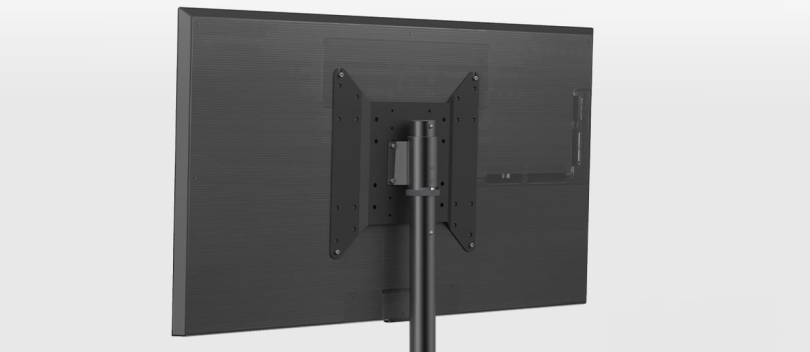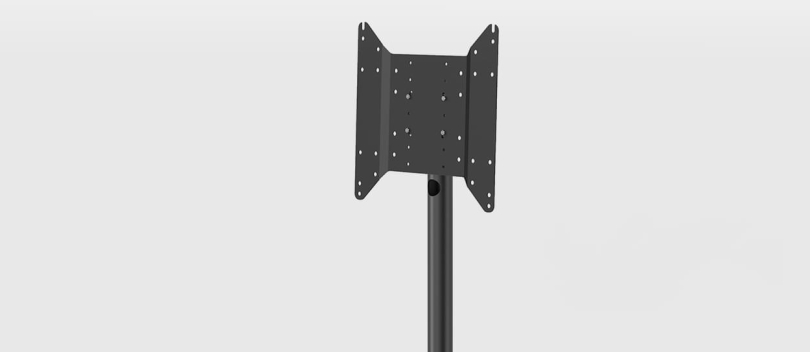
If you have ever tried to hang a TV or monitor on the wall, or considered buying a universal TV or monitor stand, you have probably come across the term 'VESA'. But what exactly does it mean? And why is it so important? Let's delve deeper into the VESA hole pattern in this blog.
VESA: What is it anyway?
VESA stands for 'Video Electronics Standards Association'. This is an international non-profit organisation that sets standards for the video electronics industry. One of the best-known standards introduced by VESA is the standard for mounting flat-screen TVs and monitors. This standard is better known as the VESA hole pattern.
The VESA size allows you to fit your screen with a TV bracket and differs for each type of TV. When you want to hang a TV using a TV bracket, it is important to know what the VESA size of the TV is. If the VESA size of the TV does not correspond to the VESA size of the bracket, the TV will not be able to be mounted on the TV bracket.
What is the VESA hole pattern?
The VESA hole pattern refers to the distance between the four mounting holes on the back of a flat-screen TV or monitor. These holes are usually arranged in a square or rectangular pattern. The size is usually indicated in millimetres and indicates the horizontal and vertical distance between the holes, for example 200x200 mm or 400x400 mm.
By having a standardised hole pattern, TV bracket and stand manufacturers can design products that go with a wide range of screens, regardless of brand or model. This also applies to speaker stands.
Where exactly are those VESA holes located?
In the past, the four suspension holes, or VESA hole pattern, were always in the centre of your screen. That's why people often called it the 'height of the centre of the screen'. But that has changed. Now it's called 'height of the centre of the VESA holes', because not all new TVs have those holes in the centre.
Take, for example, some OLED TVs from LG. All the technical parts are at the bottom of the TV and the top is just a thin piece of glass. That looks nice, but because of that, the suspension holes are also at the bottom. And that means many ordinary TV brackets won't fit. Other OLED TVs do have those holes closer to the centre.
Q-LED screens often have the suspension holes just above the centre. You need to take that into account too.

What to look out for when buying something to hang your TV
If the mounting holes are in the centre of your screen, you don't need to worry. But if they're somewhere else, there are a few things to look out for:
- TV brackets: Many TV brackets have horizontal arms. If your TV's holes are too low, those arms might stick out below or above your TV. It's better to choose a bracket that fits exactly, or one with horizontal suspension.
- TV stands: The same goes for TV stands. Many stands have vertical arms, so if the holes are too low or high, those arms may protrude. Rather choose a stand with horizontal supports or one that fits exactly.
Also, sometimes people still hear about 'height from the centre of the screen' when talking about a TV stand. But actually they should be talking about 'height of the centre of the VESA holes'.
Why is VESA important?
The VESA hole pattern is important for several reasons:
- Universal compatibility:The VESA standard allows consumers to buy any TV bracket or stand and be confident that it will fit their TV or monitor.
- Safety: By following a standard hole pattern, manufacturers can ensure that the bracket or stand can safely support the weight and size of the screen.
- Ease of use: It removes confusion when choosing the right mounting solution for your screen.
And what is a VESA adapter
A VESA adapter is a tool used to adjust the mounting points of a TV or monitor so that it can go together with a VESA mounting stand. Not all screens have a VESA-compatible hole pattern from the factory, and in such cases a VESA adapter can provide the solution.
What screws come with the TV brackets?
The common screw sizes are usually used for most TVs. For example, TVs with a VESA size of 200x200 usually have M6 screws, while those with a VESA size of 400x400 have M8 screws. These sizes are standard with many manufacturers. Still, it may happen that the TV has a unique size, so the screws provided won't fit. In such a case, it is best to go to a specialist shop to buy the appropriate screws.
Dimensions of mounting points
- VESA 100x100 - The mounting points are 10 cm apart
- VESA 200x200 - The mounting points are 20 cm apart
- VESA 300x300 - The mounting points are 30 cm apart
- VESA 400x200 - The mounting points are 40 cm apart horizontally and 20 cm apart vertically
- VESA 400x400 - The mounting points are 40 cm apart
- VESA 600x400 - The mounting points are 60 cm apart horizontally and 40 cm apart vertically
How to find out the VESA size of the TV?
If you want to find the VESA size of your TV, here are some steps you can follow:
- Consult the manual: Most TV and monitor manuals mention the VESA size.
- View the back of the screen: Measure the distance (in millimetres) between the four mounting holes horizontally and vertically.
- Manufacturer's website: Often manufacturers have product specifications online where the VESA size is listed.
- Contact the manufacturer: If you can't find it, you can always contact the manufacturer for more information.
